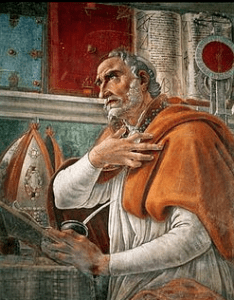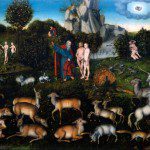I posted last week on the first part of an essay by Francisco Ayala entitled Being Human After Darwin. Today I am going to discuss the second part of this essay, but first I would like to point to an issue of Perspectives on Science and Christian Faith, the journal of the American Scientific Affiliation (The ASA is a network of Christians in the sciences). The recent issue of PSCF (v. 62 no. 3 2010) is a theme issue: Reading Genesis: The Historicity of Adam and Eve, Genomics, and Evolutionary Science. According to the website the print version is sold out; but several of the articles are available for download on the ASA PSCF Discussion blog. The topics here mesh very well with the book I am currently blogging through “Theology After Darwin (available from of Abebooks.com search on author = Berry and title = Theology After Darwin). I am going to intersperse discussion of the essays in the book and discussion of the articles in the Journal.
The article Genesis and the Genome by Dennis Venema (pp.166-178, access the pdf of the article by clicking on the reference below the abstract) puts more “flesh” on some of the argument that I was making in last Tuesday’s post. In his article Dr. Venema outlines several arguments for common descent, arguments based on gene homology using the gene coding for insulin as an example, arguments based on spatial organization, including the chromosome 2 example I used in the last post, and arguments based on pseudogenes. Dr. Venema also puts some more detail into the discussion of population size and the question of mitochondrial Eve and Y-chromosomal Adam. Ancestral population estimates using large data sets and a variety of methods return a size of something like 10,000 individuals for the interbreeding population which became human (homo sapiens). I may come back and post on his paper later in this series – especially if there are questions worth discussion.
Common descent and the discussion of the science of human origins opens the door to the more significant question: If mankind is not the pinnacle and purpose of all creation, what are we? If we evolved in continuity with the animals what makes humans distinctive creatures?
 Dr. Ayala’s essay centers in on these questions. To search for answers he considers specifically three transformations, the egg-to-adult transformation, the brain-to-mind transformation, and the ape-to-human transformation. These three transformations according to Dr. Ayala, “define the humanum, that which makes us specifically human.” He suggests that a consideration of these transformations “provide[s] a valid foundation for a religious view of humans as special creatures of God.” (p. 90) He concludes his essay looking at a fourth connection from biology to culture arising from the first three transformations.
Dr. Ayala’s essay centers in on these questions. To search for answers he considers specifically three transformations, the egg-to-adult transformation, the brain-to-mind transformation, and the ape-to-human transformation. These three transformations according to Dr. Ayala, “define the humanum, that which makes us specifically human.” He suggests that a consideration of these transformations “provide[s] a valid foundation for a religious view of humans as special creatures of God.” (p. 90) He concludes his essay looking at a fourth connection from biology to culture arising from the first three transformations.
The egg-to-adult transformation.The significance of the egg-to-adult transformation lies in the elaborate set of control mechanisms that turn genes on and off allowing differentiation and function. Dr. Ayala outlines some of the complexity involved in this transformation:
A human being consists of one trillion cells of some 300 different kinds, all derived by sequential division from the fertilized egg, a single cell 0.1 millimeters in diameter. The first few cell divisions yield a spherical mass of amorphous cells. Successive divisions are accompanied by the appearance of folds and ridges in the mass of cells and, later on, of the variety of tissues, organs, and limbs characteristic of the human individual. (p. 96-97)
In mammals, insects, and other complex organisms there are control circuits that operate at higher levels than the control circuits that activate and deactivate individual genes. These higher level circuits (such as the so-called homeobox genes) act on sets rather than individual genes. The details of how these sets are controlled, how many control systems there are and how they interact, as well as many other related questions, are what needs to be resolved to elucidate the egg-to-adult transformation. (p. 97)
The key point here is the layered complexity that leads from the information content in a simple cell to the complex functionality of an adult animal – be it a fly or a mammal. It isn’t simply a matter of the gene alone – or even the regulation of individual genes, but the regulation of groups of genes at different times and in different places. To consider the significance of humans we start with the transformation from information to organism. But we need more.
The brain-to-mind transformation. The brain is, Dr. Ayala claims, the most complex and distinctive human organ. Cell differentiation gets us to the brain – but what transforms a brain into a mind? Here Dr. Ayala opens up.
Humans have a very large brain relative to their body size, and a cerebral cortex that is disproportionately large even for their brain size. Abstract thinking, symbolic language, complex social organizations, values and ethics are manifestations of the wondrous capacity of the human brain to gather information about the external world and to integrate that information and react flexibly to what is perceived. (p. 99)
The significance here is that the DNA sequence, according to Dr. Ayala, is not large enough to specify the connections of a human brain. Again there must be a hierarchy of instruction and control. The brain – like the more rudimentary precursors, from light sensitive spots to the response of Paramecium to chemical change – allows information and response. But it does so much more – allowing creative synthesis.
Human beings have developed the ability to transcend natural selection – the means by which most organisms adapt to changes in the environment. The mind enables a new mode of evolution and development. “Humans, and humans alone, have developed the capacity to adapt to hostile environments by modifying the environments according to the needs of their genes.” (p. 99). The mind, while presumably explicable by scientific means, transcends the chemistry and physics in some significant ways – with a hierarchy leading to curiosity and the ability to understand and control. Rudimentary abilities are seen in animals, from insects to primates, but human flexibility, control, and abstraction is unparalleled. Humans study the genome and the universe, look for ways to heal and explore.
The ape-to-human transformation. Here we see what Dr. Ayala views as another instance of the human distinctive. Humans are not “gene machines” contra Dawkins.
In humans, the ‘environment’ takes a new dimension, and becomes the dominant one. Humans manipulate the natural environment so that it fits the nees of their biological make-up; for example, making clothing and houses to live in cold climates. Moreover, the products of human technology – art, science, political institutions, and the like – are dominant features of human environments. (p. 101)
The ape-to-human transformation is centered in the development of the brain. Dr. Ayala notes that genes active in the brain have changed more in humans than chimps, that the fastest evolving genes encode for transcription factors (proteins operating to control gene expression), genes (eg FOXP2) involved in speech. “In an important sense, the most distinctive human features are those expressed in the brain, those that account for the human mind and for human identity.” (p. 103)
From Biology to culture. The three transformations outlined lead, as intimated above, to a fourth transformation – the transformation from biology to culture. What makes us human is not the simple biology and biochemistry – but the development of the brain to the extent that it allows and enables culture. Development and heredity now include a ‘superorganic’ component.
Cultural inheritance makes possible for people what no other organism can accomplish – the cumulative transmission of experience from generation to generation. Animals can learn from experience, but they do not transmit their experiences, their ‘discoveries’ (at least not to any large extent) to the following generations. Animals have individual memory, but they do not have a ‘social memory’. Humans, on the other hand, have developed a culture because they can transmit cumulatively their experiences from generation to generation. (p. 104)
Cultural adaptation has prevailed in mankind over biological adaptation because it is a more rapid mode of adaptation and because it can be directed. A favorable genetic mutation newly arisen in an individual can be transmitted to a sizable part of the human species only through innumerable generations. However, a new scientific discovery or technical achievement can be transmitted to the whole of mankind, potentially at least, in less than one generation. Moreover, whenever a need arises, culture can directly pursue the appropriate changes to meet the challenge. On the contrary, biological adaptation depends on the accidental availability of a favorable mutation, or of a combination of several mutations, at the time and place where the need arises. (p. 104-105)
Humans are not distinctive because of biology or origin – but because of mind and culture. We stand on the shoulders of those who came before, not simply in our biological composition, but more importantly and more profoundly in our knowledge, our understanding, and our culture, in the knowledge of good and evil, in the awareness that things could be better. There is a thread in this essay that treads a bit close to a progressive gospel – the idea that we are, of our own making, getting better and better. But I don’t think that this is really the important take-home message. Humans are human collectively and in the context of culture.
What do you think, is Dr. Ayala on to something here? What impact does this, or might this, have on theology?
If you wish to contact me directly you may do so at rjs4mail[at]att.net
You can subscribe to a full text feed of my posts at Musings on Science and Theology.











